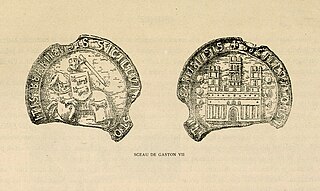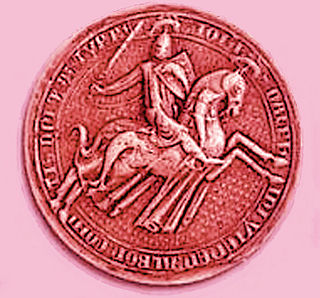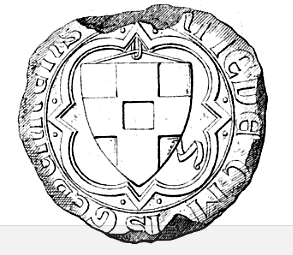
Peter II, called the Little Charlemagne, was Count of Savoy from 1263 until his death in 1268. He was also holder of the Honour of Richmond, Yorkshire, England and briefly, from 1241 until 1242, castellan of Dover Castle and Keeper of the Coast. In 1243 he was granted land by the Thames in London where he later built the Savoy Palace.

Amadeus V was Count of Savoy from 1285 to 1323.

Faucigny is a commune in the Haute-Savoie department in the Auvergne-Rhône-Alpes region in south-eastern France.
Guigues VII (1225–1269), of the House of Burgundy, was the dauphin of Vienne and count of Albon, Grenoble, Oisans, Briançon, Embrun, and Gap from 1237 to his death. He was the son of Andrew Guigues VI and Beatrice of Montferrat. When his father died, his mother helped guide the leadership of the new Dauphin.

Andrew Guigues VI, known as André de Bourgogne, Dauphin of Viennois, was the Count of Albon, Briançon, Grenoble, and Oisans from 1228 until his death. He was the son of Hugh III of Burgundy and Béatrice of Albon. He took his regnal name after and inherited the titles and lands of his maternal grandfather, Guigues V.

Gaston VII de Montcada, called Froissard, was the twentieth Viscount of Béarn from 1229. He was the son and heir of Guillermo II de Montcada of the House of Montcada and of Garsenda, daughter of Alfonso II of Provence and Garsenda of Forcalquier. He was succeeded by Roger-Bernard III of Foix.

Humbert I of Viennois was baron of la Tour-du-Pin and then also became, by his marriage, dauphin of Viennois. He was the son of Albert III, baron of la Tour-du-Pin, and of Béatrice de Coligny.

Jean II de la Tour du Pin succeeded his father Humbert I as dauphin of Viennois from 1306 to 1318. His mother was Anne of Burgundy, dauphine du Viennois.

Béatrice, Countess of Albon and Dauphine of Viennois (1161–1228) was ruling countess and dauphine in 1162–1228, in succession upon the death of her father Guigues V.
Beatrice of Hungary was a Dauphine of Viennois by marriage to John II of Viennois.

Beatrice of Montferrat was an Italian noblewoman, the eldest daughter of William VI, Marquess of Montferrat, and the third wife of Guigues VI of Viennois, by whom she had two sons. According to the vida of the troubadour Gauseran de Saint-Leidier, Beatrice was the domna (lady), whom he allegedly loved. He celebrated his idealised devotion to her in his cansos.
Aymon II was the Count of Geneva from 1265. He was the son and heir of Count Rudolf, but died heirless himself and was succeeded by his brother Amadeus II. According to one modern historian, he was “overawed by the power of the count of Savoy”, and did little during his fifteen-year reign to recover the lands and jurisdictions lost to the Savoyards by his father and grandfather.

Amadeus II was the Count of Geneva, which included the Genevois, but not the city of Geneva, from 1280 to 1308. He was the second son of Count Rudolf and succeeded his heirless brother Aymon II.

Agnes of Faucigny was suo jure ruling Dame of Faucigny from 1253, as well as countess consort of Savoy by marriage to Peter II, Count of Savoy.

Marguerite of Burgundy, was Countess of Savoy from 1233 until her death by marriage to Amadeus IV, Count of Savoy. She was the youngest daughter of Hugh III, Duke of Burgundy, and his second wife, Béatrice of Albon.

Beatrice of Savoy ruled as Lady of Faucigny, having succeeded her mother, Agnes of Faucigny. She was the only legitimate child of Peter II, Count of Savoy, but did not inherit the county, which passed instead to her uncle. Beatrice was also Dauphine of Viennois and Viscountess of Béarn by her two marriages.
William III of Geneva was the Count of Geneva from 1308 to 1320. He was the son of count Amadeus II of Geneva, and Agnès, daughter of John, Count of Chalon.












